The demand for web developers increases day by day,it is very hard to not choose the appropriate one in specialization. Among the most sought-after stacks, we find MERN stack development and MEAN stack development, which boast a really elaborate tooling to build dynamic web applications. So, which one do you have to choose from? Let’s see the differences, advantages, and use cases of each to help you decide.

What is MEAN Stack Development?
A MEAN stack is a JavaScript-based technology stack consisting of
1. MongoDB – NoSQL database for efficient data management.
2. Express.js – Framework for web application development with Node.js.
3. Angular – Frontend framework developed by Google used to develop dynamic user interface
4. Node.js – Runtime environment that enables running JavaScript on the server-side.
Advantages of MEAN Stack Development
- Two-way data binding: Angular provides real-time syncing between model and view layers.
- Full-stack JavaScript: Developers may work on both client and server sides using the same language.
- Scalable applications: Great for enterprise-grade apps because Angular follows a structured framework.
- Community support: Immense developer community support, primarily with Angular.
What is MERN Stack Development?
The MERN stack is another JavaScript-based stack, but in this, Angular is replaced by React. It consists of:
1. MongoDB – The database layer
2. Express.js – The backend framework
3. React – A JavaScript library for building user interfaces, maintained by Facebook
4. Node.js – The server-side runtime
Advantages of MERN Stack Development
- Component-Based Architecture: React simplifies UI development with reusable components.
- Virtual DOM: React’s virtual DOM improves application performance.
- Flexibility: React offers more flexibility compared to Angular, making it suitable for diverse project requirements.
- Rich Ecosystem: A plethora of libraries and tools support React-based development.
Key Differences Between MEAN and MERN Stacks
| Feature | MEAN Stack Development | MERN Stack Development |
| Front-End Framework | Angular | React |
| Learning Curve | Steeper (due to Angular’s complexity) | Relatively easier (React is lightweight) |
| Performance | Ideal for large-scale apps with complex logic | Better for dynamic, interactive UIs |
| Flexibility | More structured, opinionated framework | Highly flexible and customizable |
| Community Support | Strong Angular community | Growing React ecosystem |
Which Stack To Select?
Select MEAN Stack Development If:
- You want a structured framework for front-end development.
- Your projects need enterprise-level features and scalability.
- You want smooth and effortless flow of data from the server to the client.
Select MERN Stack Development If:
- Performance and a dynamic nature of user interface matters the most.
- Want more flexibility in the selection of libraries as well as tools.
- Application development focused on interactivity.
Career Opportunities in MEAN and MERN Stack Development
Both stacks provide promising career opportunities for would-be developers.
- MEAN Stack Development: Among those in high demand for big enterprise-level applications in sectors like finance, healthcare, and e-commerce.
- MERN Stack Development: More popular among fresh startups, social media apps, and uses that are user experience-oriented.
Conclusion
When choosing between developing in MERN or MEAN, one is to consider career targets, project requirements, and learning preferences. While they are both powerful stacks, it all depends on the needs met within the web development ecosystem. requirements, and learning preferences. Sign up for more specialized training courses or programes; this hands-on training will give you an upper hand in the competitive backdrop of tech. Whether it’s MERN or MEAN, proficiency in either stack will lead to some exhilarating opportunities in web development.
